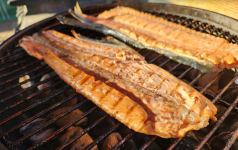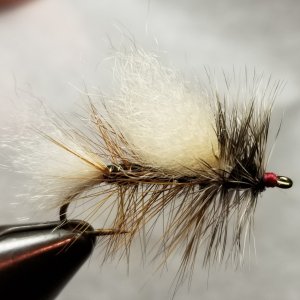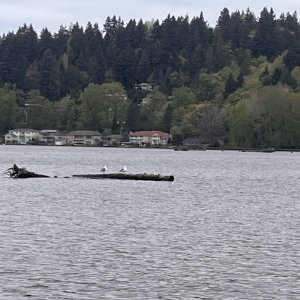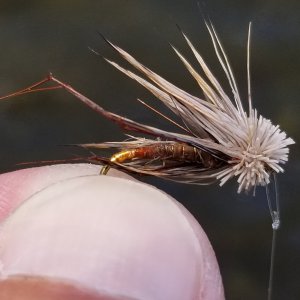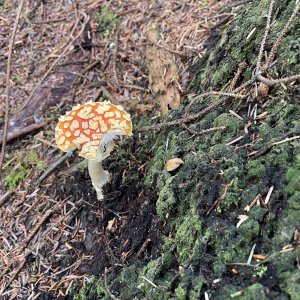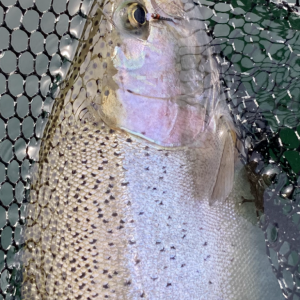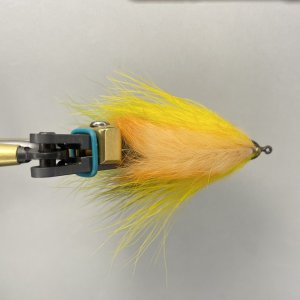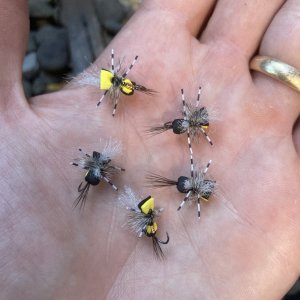Navigation
Install the app
How to install the app on iOS
Follow along with the video below to see how to install our site as a web app on your home screen.
Note: This feature may not be available in some browsers.
More options
Style variation
You are using an out of date browser. It may not display this or other websites correctly.
You should upgrade or use an alternative browser.
You should upgrade or use an alternative browser.
BBQ Salmon... foil or direct on the grill?
- Thread starter Josh
- Start date
I also read that my beloved teriyaki is a fairly recent product of Hawaii, refined in Seattle, though based on much older Japanese traditions. And that the Japanese did not, in fact, particularly like the taste of salmon before the advent of easy freezing.I read that Bristol Bay harvest is forecast for 37 million sockeye this year, after 60 million last year. Maybe more cohos for us too? I hope so!
I like the taste of salmon with teriyaki, and learning new things on the internet, but I’m particularly looking forward to seeing a few cutthroat later this week. More water, less screen!
I'll take you up on that. Much as I love fresh Columbia River spring Chinook and URBs, those lower Columbia coho are also some of the best eating salmon I've caught. I think it's all those anchovies they have to swim through that fattens them up like nothing else can. Also happens in Grays Harbor too. Not your average coho!If anyone wants to put down the fly rods for a day, hit me up in September or October if you want to have some top tier salmon to take home. You'd have to drive down to the PDX area though.
I have a pretty good program dialed for thoseI'll take you up on that. Much as I love fresh Columbia River spring Chinook and URBs, those lower Columbia coho are also some of the best eating salmon I've caught. I think it's all those anchovies they have to swim through that fattens them up like nothing else can. Also happens in Grays Harbor too. Not your average coho!
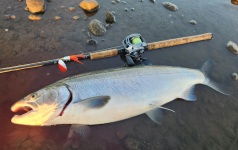
While I said I don't use foil on the grill, I always do when cooking in the oven, for precisely the same reason. Quick, easy cleanup is always a win!Foil tray. The skin sticks to it so when you're done the skin and foil roll up together for the trash can.
Sir Homey
Steelhead
There are some interesting and cringe-worthy responses here. No wrong answers of course, just some individuals that need guidance. 
Being an east coaster that moved west decades ago and knew nothing of salmon or how to cook it, I feel I’ve run the gamut from heinous atrocities to finally getting it somewhat right. Put me in the plank camp. Foil? Never. One thing I’ve found during my crusade to sway everyone over to planks is that new converts don’t seem to grasp the idea that your grilling plank gets tossed after a single use. No, you’re not using that plank all summer. Stock up, once you discover the joys of planking you’ll be slapping everything you can find on a plank.
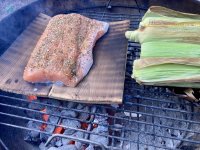
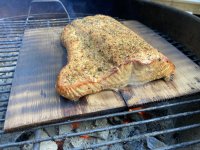
I’ve found halibut to be a good choice as well. Like I said, plank it all.

Being an east coaster that moved west decades ago and knew nothing of salmon or how to cook it, I feel I’ve run the gamut from heinous atrocities to finally getting it somewhat right. Put me in the plank camp. Foil? Never. One thing I’ve found during my crusade to sway everyone over to planks is that new converts don’t seem to grasp the idea that your grilling plank gets tossed after a single use. No, you’re not using that plank all summer. Stock up, once you discover the joys of planking you’ll be slapping everything you can find on a plank.


I’ve found halibut to be a good choice as well. Like I said, plank it all.

The three slabs of salmon with herbed butter balls on top in a ready to bake foil dish at costco is pretty great for a working folks dinner!Well now that all the elite salmon religious people had their say.
Here is real life on the inland PNW side:
Tired as fuck after work. Stop at the store, buy the shittiest light pink (probably dyed that color) farm raised salmon. Usually spring for the 10.99 special, as it's bullshit a proper cooked dinner costs 30-50 bucks a day. I'm not poor, but I hate the cost of food lol.
Get home, give it a good smell, and feel the slime. Is it good? I dunno, fuck it, I'm hungry.
Cook it up. I won't dive into grill, oven, whatever, I understand that's the point here, but obviously whatever recipe I state doesn't matter by this point.
Take it off the grill, as perfectly cooked as it can be. The wife whines that it's still raw and she wants it flakey. I mutter, sure give me your half and I'll ruin it just like your well done steaks.
The you clean up, and pray that smell doesn't translate into food poisoning or anything.
Just some simple facts of life here. Haha
Sorry. Had to make a post like this after reading 4 pages of elitism. Trying to help the common folk feel more at home here.
That looks really good. I've had some good planked salmon. One thing I always wondered though--why cedar? Is it because it is readily available as a shingle/plank? I always thought alder seemed like the more logical choice. I like the smell of cedar smoke but always wondered if those were the best flavors for getting into my fish.There are some interesting and cringe-worthy responses here. No wrong answers of course, just some individuals that need guidance.
Being an east coaster that moved west decades ago and knew nothing of salmon or how to cook it, I feel I’ve run the gamut from heinous atrocities to finally getting it somewhat right. Put me in the plank camp. Foil? Never. One thing I’ve found during my crusade to sway everyone over to planks is that new converts don’t seem to grasp the idea that your grilling plank gets tossed after a single use. No, you’re not using that plank all summer. Stock up, once you discover the joys of planking you’ll be slapping everything you can find on a plank.
View attachment 67985
View attachment 67986
I’ve found halibut to be a good choice as well. Like I said, plank it all.
View attachment 67988
Sir Homey
Steelhead
Good question. Tradition? Availability?That looks really good. I've had some good planked salmon. One thing I always wondered though--why cedar? Is it because it is readily available as a shingle/plank? I always thought alder seemed like the more logical choice. I like the smell of cedar smoke but always wondered if those were the best flavors for getting into my fish.
Definitely try out as many different woods as you can. Certain meats go better with certain woods. The gist of it all is still the same.
SilverFly
Legend
Never have. Don't forget collars, although they usually go in the smoker.and seriously guys, stop throwing away the spines/backs. You're missing out on some of the best meat.
View attachment 67992
On the quality discussion:
Having been here about 25 years now, I have come to realize that I really don't like the flavor of salmon flesh, but I adore the flavor of salmon FAT. I've eaten all the native species, in lots of varying degrees of freshness/quality, and anymore, I only really enjoy the very fattiest, freshest of salmon, caught in the ocean or within a couple days of entering a river (preferably the Columbia). Anything less I either have to smoke, dress up with sauces, or simply choke down. Those are the fish I usually share with friends and neighbors who love eating salmon in general and will appreciate them.
IMO, Like so many foods, how "good" any salmon, regardless of preparation, ends up being depends more on what you start with than anything else. Of course, the art of classical cooking is really more about making more marginal cuts taste palatable, or even good, so the best "recipes" probably come from places where super fresh salmon isn't as readily available. We salmon snobs (I own it) don't have to do anything special to make it taste good. Indeed, we have to try pretty hard to screw it up.
Having been here about 25 years now, I have come to realize that I really don't like the flavor of salmon flesh, but I adore the flavor of salmon FAT. I've eaten all the native species, in lots of varying degrees of freshness/quality, and anymore, I only really enjoy the very fattiest, freshest of salmon, caught in the ocean or within a couple days of entering a river (preferably the Columbia). Anything less I either have to smoke, dress up with sauces, or simply choke down. Those are the fish I usually share with friends and neighbors who love eating salmon in general and will appreciate them.
IMO, Like so many foods, how "good" any salmon, regardless of preparation, ends up being depends more on what you start with than anything else. Of course, the art of classical cooking is really more about making more marginal cuts taste palatable, or even good, so the best "recipes" probably come from places where super fresh salmon isn't as readily available. We salmon snobs (I own it) don't have to do anything special to make it taste good. Indeed, we have to try pretty hard to screw it up.
Columbia fish kind of ruin you. They're on a whole other level from the other PNW stocks. Especially the springers.On the quality discussion:
Having been here about 25 years now, I have come to realize that I really don't like the flavor of salmon flesh, but I adore the flavor of salmon FAT. I've eaten all the native species, in lots of varying degrees of freshness/quality, and anymore, I only really enjoy the very fattiest, freshest of salmon, caught in the ocean or within a couple days of entering a river (preferably the Columbia). Anything less I either have to smoke, dress up with sauces, or simply choke down. Those are the fish I usually share with friends and neighbors who love eating salmon in general and will appreciate them.
IMO, Like so many foods, how "good" any salmon, regardless of preparation, ends up being depends more on what you start with than anything else. Of course, the art of classical cooking is really more about making more marginal cuts taste palatable, or even good, so the best "recipes" probably come from places where super fresh salmon isn't as readily available. We salmon snobs (I own it) don't have to do anything special to make it taste good. Indeed, we have to try pretty hard to screw it up.
Edit: not so much the tules, though.
Last edited:
and seriously guys, stop throwing away the spines/backs. You're missing out on some of the best meat.
View attachment 67992
I like to cook the backbones / spines then scrape off the meat. I then use the meat to make salmon burgers.
SF
jact55
Life of the Party
To those who responded to my post.
It was 98% for humor, 2% to poke the elitist (just the term that came to mind, dont put alot of worth onto that word), but with a hidden amount of personal jealousy haha, and 100% to see if i can get some rises.
Although my sad story holds alot of truths about my salmon process.
I don't have a dog in the fight on ways to grill.
I do the oven most the time.
Sometimes evoo, salt, pepper and dill
Sometimes butter, onions and lemon
Sometimes with a ginger citrus and brown sugar glaze.
Tonight, I'm cooking the salmon plain as can be. Olive oil, salt, pepper. Let cool.
And mixing into a fruit and veggie Salad with lettuce, tomatoe, onion, carrot, blueberry, apply, pear, almonds and a citrus vinaigrette.
....that should hide the flavor of the farmed salmon lol.
I do take pride in my cooking. When time allows.
But most of all, I'm an immature facetious turd haha
It was 98% for humor, 2% to poke the elitist (just the term that came to mind, dont put alot of worth onto that word), but with a hidden amount of personal jealousy haha, and 100% to see if i can get some rises.
Although my sad story holds alot of truths about my salmon process.
I don't have a dog in the fight on ways to grill.
I do the oven most the time.
Sometimes evoo, salt, pepper and dill
Sometimes butter, onions and lemon
Sometimes with a ginger citrus and brown sugar glaze.
Tonight, I'm cooking the salmon plain as can be. Olive oil, salt, pepper. Let cool.
And mixing into a fruit and veggie Salad with lettuce, tomatoe, onion, carrot, blueberry, apply, pear, almonds and a citrus vinaigrette.
....that should hide the flavor of the farmed salmon lol.
I do take pride in my cooking. When time allows.
But most of all, I'm an immature facetious turd haha
Not true in my experience. Simply over cook a perfect piece of salmon, and it's screwed up IMO. When people ask me about cooking time for salmon, I say that it's better to under cook by 2 minutes than to over cook by 1 minute. Fish is delicate, sensitive stuff.Indeed, we have to try pretty hard to screw it up.
brownheron
corvus ossifragus
Pot stirring...
Farmed vs. wild salmon: Can you taste the difference?
Panelists assess 10 samples of farm-raised and wild-caught salmon during a blind taste test at The Washington Post. To prepare the fillets for tasting, local chef Scott Drewno lightly salted and steamed them onsite. (Sarah L. Voisin/The Washington Post)
By Tamar Haspel
September 24, 2013
Read a story about salmon, and the odds are good that, somewhere, it’ll tell you that wild salmon tastes better than farmed. But does it? We decided to find out in a blind tasting, and assembled a panel that included noted Washington seafood chefs and a seafood wholesaler.
The fish swam the gamut. We had wild king from Washington, frozen farmed from Costco, and eight in between, including Verlasso farmed salmon from Chile, which is the first open-pen farmed salmon to get a Seafood Watch “buy” recommendation. The tasters came from the Food section and the local seafood scene.
Scott Drewno, executive chef of the Source by Wolfgang Puck, was gracious enough to prepare the fish; this was like Usain Bolt consenting to go for a jog. Drewno steamed portioned fillets simply, with a little salt.
The judgments were definitive, and surprising. Farmed salmon beat wild salmon, hands down. The overall winner was the Costco frozen Atlantic salmon (Norwegian), added to the tasting late in the game — to provide a counterpoint to all that lovely fresh fish, we thought.
There is an important caveat about the winning salmon: It was packed in a 4 percent salt solution. Many of the tasters noted, and liked, the saltiness. Chef-restaurateur Kaz Okochi (Kaz Sushi Bistro, Masa 14) mentioned that salt doesn’t only affect flavor but also helps make the texture of the fish firmer. Salting is “a typical Japanese technique for fish” and one he uses on salmon sushi. The Costco/Kirkland label product was a fine piece of fish, and one any of us would put on the table. Yet it wasn’t strictly comparable to the others. It was also about $5 per pound cheaper than any of them.
The next three top-rated fish, with closely grouped scores, also were farmed: Trader Joe’s, from Norway; Loch Duart, from Scotland; and Verlasso.
Ancora chef-restaurateur Bob Kinkead, who estimates that he personally has garnished upward of 350,000 servings of Pepita Salmon, a signature dish at the now-closed Kinkead’s (“Salmon built my house,” he says), seemed disheartened that there was so little difference among the fish. “None stood out and said, ‘Buy me,’ ” he said.
When standout flavors were detected, it wasn’t in a good way. A couple of samples had off-flavors that were picked up by some tasters but not by all. And, although some samples had either the large flake and high fat content that gave them away as farmed, or the finer grain and meaty texture that identified them as wild, we could not consistently tell which was which.
One thing, though, is certain. You’ll never catch any of us saying wild salmon tastes better than farmed.
Other panelists: Bonnie S. Benwick, Tim Carman and Jane Touzalin of The Post and John Rorapaugh, director of sustainable initiatives at ProFish.
The fish, in order of panel preference (overall ratings 1-10, with 10 being the highest score):
1. Costco farmed Atlantic, frozen in 4 percent salt solution, from Norway; $6 per pound (7.6 out of 10)
2. Trader Joe’s farmed Atlantic, from Norway; $10.99 per pound (6.4)
3. Loch Duart farmed Atlantic, from Scotland; $15 to $18 per pound (6.1)
4. Verlasso farmed Atlantic, from Chile; $12 to $15 per pound (6)
5. Whole Foods farmed Atlantic salmon, from Scotland; $14.99 per pound (5.6)
6. ProFish wild king (netted), from Willapa Bay, Wash.; $16 to $20 per pound (5.3)
7. AquaChile farmed Atlantic, from Chile; $12 to $15 per pound (4.9)
8. ProFish wild coho (trolled), from Alaska; $16 to $20 per pound. (4.4)
9. ProFish wild king (trolled), from Willapa Bay; $16 to $20 per pound (4)
10. Costco wild coho, from Alaska; $10.99 per pound (3.9)
Farmed vs. wild salmon: Can you taste the difference?
Panelists assess 10 samples of farm-raised and wild-caught salmon during a blind taste test at The Washington Post. To prepare the fillets for tasting, local chef Scott Drewno lightly salted and steamed them onsite. (Sarah L. Voisin/The Washington Post)
By Tamar Haspel
September 24, 2013
Read a story about salmon, and the odds are good that, somewhere, it’ll tell you that wild salmon tastes better than farmed. But does it? We decided to find out in a blind tasting, and assembled a panel that included noted Washington seafood chefs and a seafood wholesaler.
The fish swam the gamut. We had wild king from Washington, frozen farmed from Costco, and eight in between, including Verlasso farmed salmon from Chile, which is the first open-pen farmed salmon to get a Seafood Watch “buy” recommendation. The tasters came from the Food section and the local seafood scene.
Scott Drewno, executive chef of the Source by Wolfgang Puck, was gracious enough to prepare the fish; this was like Usain Bolt consenting to go for a jog. Drewno steamed portioned fillets simply, with a little salt.
The judgments were definitive, and surprising. Farmed salmon beat wild salmon, hands down. The overall winner was the Costco frozen Atlantic salmon (Norwegian), added to the tasting late in the game — to provide a counterpoint to all that lovely fresh fish, we thought.
There is an important caveat about the winning salmon: It was packed in a 4 percent salt solution. Many of the tasters noted, and liked, the saltiness. Chef-restaurateur Kaz Okochi (Kaz Sushi Bistro, Masa 14) mentioned that salt doesn’t only affect flavor but also helps make the texture of the fish firmer. Salting is “a typical Japanese technique for fish” and one he uses on salmon sushi. The Costco/Kirkland label product was a fine piece of fish, and one any of us would put on the table. Yet it wasn’t strictly comparable to the others. It was also about $5 per pound cheaper than any of them.
The next three top-rated fish, with closely grouped scores, also were farmed: Trader Joe’s, from Norway; Loch Duart, from Scotland; and Verlasso.
Ancora chef-restaurateur Bob Kinkead, who estimates that he personally has garnished upward of 350,000 servings of Pepita Salmon, a signature dish at the now-closed Kinkead’s (“Salmon built my house,” he says), seemed disheartened that there was so little difference among the fish. “None stood out and said, ‘Buy me,’ ” he said.
When standout flavors were detected, it wasn’t in a good way. A couple of samples had off-flavors that were picked up by some tasters but not by all. And, although some samples had either the large flake and high fat content that gave them away as farmed, or the finer grain and meaty texture that identified them as wild, we could not consistently tell which was which.
One thing, though, is certain. You’ll never catch any of us saying wild salmon tastes better than farmed.
Other panelists: Bonnie S. Benwick, Tim Carman and Jane Touzalin of The Post and John Rorapaugh, director of sustainable initiatives at ProFish.
The fish, in order of panel preference (overall ratings 1-10, with 10 being the highest score):
1. Costco farmed Atlantic, frozen in 4 percent salt solution, from Norway; $6 per pound (7.6 out of 10)
2. Trader Joe’s farmed Atlantic, from Norway; $10.99 per pound (6.4)
3. Loch Duart farmed Atlantic, from Scotland; $15 to $18 per pound (6.1)
4. Verlasso farmed Atlantic, from Chile; $12 to $15 per pound (6)
5. Whole Foods farmed Atlantic salmon, from Scotland; $14.99 per pound (5.6)
6. ProFish wild king (netted), from Willapa Bay, Wash.; $16 to $20 per pound (5.3)
7. AquaChile farmed Atlantic, from Chile; $12 to $15 per pound (4.9)
8. ProFish wild coho (trolled), from Alaska; $16 to $20 per pound. (4.4)
9. ProFish wild king (trolled), from Willapa Bay; $16 to $20 per pound (4)
10. Costco wild coho, from Alaska; $10.99 per pound (3.9)


